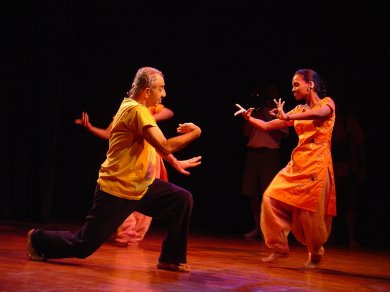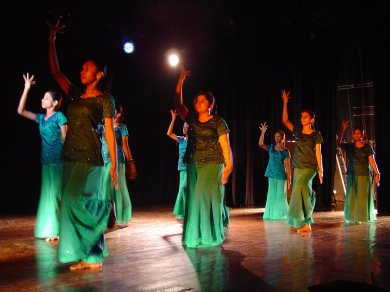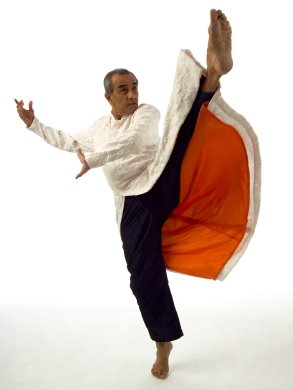
|
 |

|
 |
Astad Deboo: I'm not using dance as therapy but as an art form - Shveta Arora e-mail: shwetananoop@gmail.com April 6, 2016 Globally acclaimed contemporary dancer Astad Deboo has to his credit many exciting collaborations, but most exciting is his work with the deaf, creating full-scale dance productions with people who can't even hear the music. Astad speaks on his inspirations and the challenges he faces in this path-breaking work.  Contraposition rehearsal  Contraposition performance What was your initial inspiration to start on this journey with deaf people? When I was trying to create work with other dancers and I was returning from an overseas journey, I just happened to meet these young deaf actors. I asked the director if I could hold a workshop for them and give them movement. For two years I did that, and then the actors themselves expressed a desire that I should spend more time with them. The following year I spent three weeks with them. I thought they had great potential and I needed to mentor them and bring them to a certain level. I came in contact with other deaf groups and I mentored people in a university in Washington. That's how my journey began.  Karthika & Astad Deboo in Contraposition Photo: Monika Ghurde What are the challenges that you face in every new production when you adapt the storyline, music and choreography to suit the needs of the deaf? I don't, so to say, adapt. I know that I have a challenge to work with, that is, they cannot hear. The first thing that is taught to them is to count, like for a rhythm of eight. Once they learn to count, there is a uniformity and that is the beginning. With certain groups, like the Calcutta group, they were actors and I had to introduce dance movement. It was a limitation since they did not know dance movements. And I gave them movements that could be easily assimilated. This was easy since age-wise, they were 18 and above. With the other group from Chennai's Clarke School, they were already trained in Bharatanatyam. So they already had a dance vocabulary and it was easy for them to pick up my movements. They were simple but there was control, balance, and with them, I created a 60-minute production titled Contraposition. This was a one-hour non-stop seamless production, and for this, I worked very closely with the music composer also. It was based on rasas. Each rasa had a different beat. If I could work on what he created for me, I could break it into dance vocabulary. The process of production is different with different groups. With others, it has been a 15 to 20 minute performance. Are they able to pick up the abhinaya part of dance, the expressions and all? Abhinaya is difficult and from among the girls who danced, only two or three could work on expressions. For the others, it was difficult. So I do not work on the abhinaya part, since it is not easy. Otherwise, the work gels and portrays what I want to say in the choreography. What has been your greatest frustration, and how has working with the deaf helped you? Frustrations are always there. In India, when you are working with the deaf, you have to have the right kind of floor. Calcutta had a wooden floor, but in Chennai, there was a normal mosaic floor. The wooden floor is very important since it is through the floor that the vibrations go through. If I need them to stop, I thump on the floor and then they look at me for further instructions. In India, this is a major drawback. Secondly, sometimes, when I speak, I feel that I am not speaking to them, so they haven't caught what I am trying to say. That lack of communication happens. I push my performers to the brink of excellence. I push them hard. They break down and get frustrated. These are processes that are part of the production and when the work is applauded and appreciated, they know that it was worth it.  Astad Deboo You say it has been a pilgrimage to work with them. Please elaborate. It has been like a journey. If you see my work, I have worked in few productions with dancers. I have worked with drummers, martial artists, puppeteers. I have worked with other dancers mostly overseas. So each collaboration is like a pilgrimage to me to reach my destination, in the sense that the work is created, seen, performed, sees the light of day and is appreciated. And a pilgrimage comes to an end, and with that, I move on. I am now working with deaf children in Bangalore at the Kothavala school. It is going to come up sometime next year. It is going to be a challenge because they are neither dancers nor actors - they are just a group of enthusiastic youngsters who like moving. But their perception is different from mine. They have seen some of my work; they are aware, since I danced for them and showed them a video, so they know where they are heading. The Bangalore work is at a very preliminary stage. I don't even know what direction the choreography is going to take. It is still at the stage of workshops, with which too I am not very consistent. I have a lot of other projects going on. I have an assistant who should be able to make the movement happen even during my absence, since I travel a lot. The assistant should be able to keep the work going. The school does not have a dance teacher. I should not have to waste time when I work on the production. How does dancing help them? I'm not using dance as therapy but as an art form, in which they want to participate. Working with me also raises their level of confidence, and they become role models for their community. An art form is shared, mentored. I don't look at it (their deafness) as an impairment, I don't make any concessions for them. You have to work hard. When they make a mistake, I do not want anyone to say, "Oh, poor chap can't hear." I don't want that pity. Certain people are talented and I want them to make an effort. You must work hard and have determination. If you're an average mover, with time and practice, you'll get there, at least as part of the group if not an individual performer. It's certainly not therapy. They communicate very well, they have a language. We use the art form and get people who have talent, then help them showcase it. Contact Astad Deboo at: astaddeboo@gmail.com Post your comments Unless you wish to remain anonymous, please provide your name and email id when you use the Anonymous profile in the blog to post a comment. All appropriate comments posted with name & email id in the blog will also be featured in the site. |